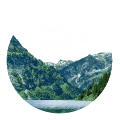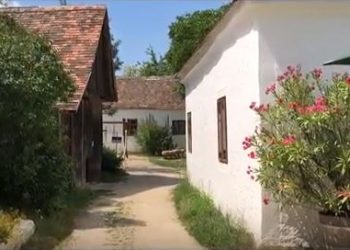In this article, we have compiled the most important information about Schneeberg mountain and its various attractions.
- Schneeberg – General Information
- Weather on the Schneeberg Summit
- The Salamander Railway and the Steam Train
- The Panoramic Paradise
- Climbing to the Summit
- Trail from the Summit Back to Puchberg Village
- Essential Information for Visiting Schneeberg Mountain
- Getting There by Public Transport from Vienna
- Attractions in the Area
- Group Trip to the Viennese Alps
Schneeberg – General Information
Schneeberg mountain (in German: Schneeberg) is the most impressive mountain in the Vienna area and the state of Lower Austria. The mountain’s peak rises to an altitude of 2,076 meters above sea level. In fact, it is the easternmost mountain in the Alps to exceed 2,000 meters. On a clear day, you can see the snowy peak of Schneeberg from several viewpoints around Vienna, such as the Kahlenberg summit or the Danube Tower, and even from neighboring Bratislava.
Schneeberg mountain, along with the Rax mountain, Semmering, and the Hohe Wand nature reserve, are known by the locals as the “Viennese Alps” due to their proximity to Vienna.
This mountainous area is rich in clear water reservoirs, and since 1873, a 120-kilometer water pipeline has been supplying drinking water to Vienna. This water is considered the best drinking water in the world!
Schneeberg mountain is located near the village of Puchberg (Puchberg am Schneeberg), from where you can ascend to the summit on an experiential train.
If you are interested in staying in the heart of the Viennese Alps, the Puchberg village area is a perfect fit. The village has a pampering spa hotel that attracts many visitors from the region and abroad. Read more about the spa hotel in Puchberg. If you are looking for other places, you can find more recommendations for accommodation in the Viennese Alps area.
Watch some of the wonderful landscapes of the Schneeberg mountain area:
Weather on the Schneeberg Summit
During the winter months, the mountain peak is covered in snow. Sometimes, remnants of snow can still be seen in March, April, and May. In the summer months (June-August), temperatures hover around 22°C on clear sunny days, and towards the evening, temperatures drop to below 10°C.
The months from May to September are considered the rainiest in this region, with an average of 10 rainy days per month.
[Placeholder for an image of the Rax and Schneeberg mountains]
At the summit, you need to account for the wind, which can be strong and cold even in summer. Also, the weather can change very quickly, so you need to be prepared for quite extreme weather changes.
It is advisable to dress in layers, with a thin layer underneath warmer clothing (preferably wind and rain resistant).
Before arriving, you can check the visibility and weather conditions on the mountain through the many cameras installed on it. These cameras broadcast continuously. Click here to view the cameras.
The Salamander Railway and the Steam Train
The modern Salamander Railway is the most comfortable and experiential way to get near the summit of Schneeberg. The train departs from the station in the village of Puchberg and reaches the upper station of the mountain (Hochschneeberg) at an altitude of 1800 meters in a 40-minute journey.
During the summer months, every Sunday and on holidays, there is an option to travel up the mountain on an old steam train that has been in operation since the days of Emperor Franz Joseph 100 years ago.
Tip: You can stop at the intermediate station (called Baumgartner) and buy one of the mountain’s famous pastries at the bakery there. This pastry is called Schneeberg Buchteln and is made of sweet dough with a jam filling.
Watch the Salamander Railway:
The Panoramic Paradise
At the upper station of the mountain, the “Panoramic Paradise” will be revealed to you. You can walk along the marked path around the edge of the mountain and enjoy wonderful views of the entire region. On beautiful days, you can see parts of Hungary, Slovakia, the Rax mountains, the Vienna area, and even as far as the Styria region.
The panoramic walking trail takes about an hour and a half and is considered easy, so it is also suitable for a trip with small children. Along the trail, there are seating areas where you can relax and enjoy the views and the clear air.
In addition to the hiking trail, at the upper train station, there is a unique art gallery called TOP ART 1800. This is the highest art gallery in Austria. The artworks are in a modern style called “Spontaneous Realism.”
Tip: At the train station, you can get an audio guide in English that will provide you with additional information about the regional history, vegetation, and landscapes. The cost of the audio guide is a few euros, and you will need to leave an ID as a deposit.
Climbing to the Summit
For more experienced hikers, there is a marked trail that starts from the upper train station and reaches the mountain peak at an altitude of about 2000 meters. The hiking trail is of moderate to difficult level. The trail takes about an hour and requires good fitness.
Trail from the Summit Back to Puchberg Village
If you want to continue enjoying the wonderful view and nature after spending time at the summit, you can walk along the marked trail down the mountain. The trail is called Zahnradbahnwanderweg and it runs right next to the railway track.
- Trail length: 10 kilometers
- Walking time: 3:15 hours
- Difficulty level: Moderate
- Starting point: The train station at the top of Schneeberg mountain
- Ending point: Puchberg am Schneeberg
- When can you do the trail: April – October
More information about the trail
Public Transport from Vienna to Schneeberg (Throughout the Year)
You can reach the Schneeberg mountain area relatively easily from Vienna. The train journey takes about an hour and a half. First, you need to take the high-speed train that leaves towards the city of Graz from Vienna’s main train station (Wien HBF). After a half-hour ride, get off at the Wiener Neustadt HBF station. Then, you need to change to the regional train (R) that goes towards Puchberg am Schneeberg and get off at this station (this is the last stop of the train). There, you will need to walk to the platform from which the Salamander Railway departs to the top of the mountain (note: the train to the summit operates only from the end of April. It is possible to hike to the summit, but this is not recommended in winter).
The cost of the trip is about €23 per passenger.
You can plan your route and arrival time using the Austrian transport company’s route planner.
This is the route as it appears on the Austrian railway website:

Essential Information for Visiting Schneeberg Mountain
Operating times of the Salamander Railway (which ascends to the Schneeberg summit): From the end of April (26.4) to the beginning of November (2.11).
- Departure times from Puchberg am Schneeberg station: 9:00, 10:30, 12:00, 14:00, 15:30
- Departure times from the station at the top of the mountain (Hochschneeberg): 9:45, 11:15, 13:15, 14:45, 16:15
Updated travel schedule on the official website Journey duration: 40 minutes Salamander Railway Website
Operating times of the old steam train: Beginning of June (1.6) to the end of September (21.9). Every Sunday on the second week of the month.
- Departure time from Puchberg am Schneeberg station: 11:23
- Departure time from the station at the top of the mountain (Hochschneeberg): 15:17 Journey duration: About an hour and a half
Costs for the train (round trip):
- Adult: €43.50
- Child (6-15): €21
- Child up to age 6: Free (must sit on a parent’s lap and not in a separate seat)
Please note: For the steam train, there is an additional charge of about €20 per passenger.
Purchase train tickets online:
Official website of the Schneeberg area
Address: Bahnhofplatz 1, Puchberg am Schneeberg
Map:
Other Attractions in the Viennese Alps Area
A short distance from Schneeberg mountain is the equally impressive Rax mountain range. Read more about the Rax area in the detailed article we have prepared on this region.
In addition, you can visit the charming Semmering mountain area, where there is a ski resort that operates in the winter months, offering sledding and skiing experiences. During the rest of the year, this area is lovely for viewing the surrounding mountains and for hiking on Alpine nature trails.


















